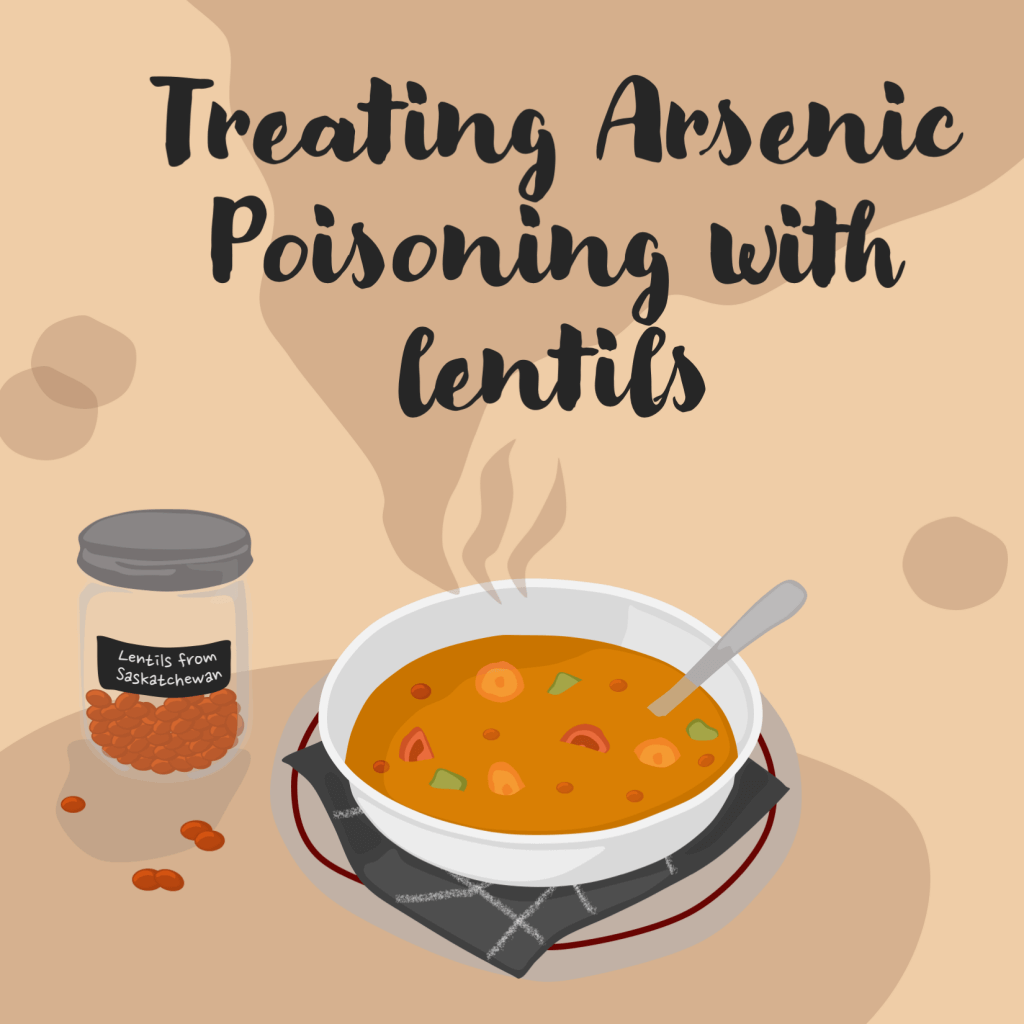
Written by Hayley McKay
Illustrated by Tammy Lee
Arsenic poisoning plagues over 100 million people around the world, mostly because of contaminated water. In countries like Bangladesh, where improperly filtered groundwater is used, the drinking water has particularly high levels of arsenic. Arsenic poisoning can manifest in a variety of symptoms from darkened spots on skin and weakened immune systems, to respiratory diseases, loss of extremities and even cancer. Arsenic-filtering pumps were once installed across Bangladesh, which helped curb arsenic levels in drinking water for about a year. But unfortunately, the pumps eventually broke and no one in the community had the resources or knowledge to fix them, resulting in elevated arsenic levels once again.
So how can arsenic poisoning be avoided in a more sustainable manner? The short answer: Canadian lentils.
Canada is the world’s largest producer and exporter of lentils, which are consumed daily in more than 100 countries. Part of the legume family, lentils are very nutritious, don’t need much preparation and are generally inexpensive, meaning they are a staple food for many communities in Asia and Africa.
As it turns out, Canadian lentils – specifically those cultivated in regions of Saskatchewan – have some of the highest levels of micronutrients in the world! Albert Vandenberg, a scientist at the University of Saskatchewan who studies lentils and other legumes, has found that due to the soil and temperate summer climate in Saskatchewan, lentils cultivated there contain a huge amount of iron, zinc and selenium – micronutrients essential for human health.
But what have micronutrients got to do with arsenic poisoning? A great deal it seems. Selenium appears to play an important role in reducing the effects of high arsenic levels in drinking water. Judit Smits, a veterinary and toxicology researcher at the University of Calgary (and wife of Albert Vandenberg), noticed that during a drought in Saskatchewan, animals began eating the only thing still growing: the red lentils with high levels of selenium. These animals began developing selenium poisoning and were treated with a safe form of arsenic to flush out the excess selenium.
When arsenic and selenium are in the stomach and intestines of an animal, they form a large complex which is too big to get absorbed into the blood, so the animal excretes it in its urine instead. After observing this, Dr. Smits wondered if the process could be reversed to treat arsenic poisoning, and if the lentils her husband, Dr. Vandenberg, had been developing could be used to deliver selenium supplements.
After a successful animal study, Dr. Smits and Dr. Vandenberg moved on to a clinical trial to see if Saskatchewan-grown lentils with high selenium content could indeed treat arsenic poisoning. The pair decided to execute their study in Bangladesh where lentils are already familiar and widely consumed. They randomly sampled about 400 generally healthy people with elevated arsenic levels due to contaminated water, separating them into two groups: one who were fed the selenium-rich lentils from Saskatchewan, and the other who were fed local lentils with low selenium levels.
To monitor the effects of the lentils on arsenic levels, researchers took samples of urine, feces and hair from before and over the course of the trial. They also monitored the presence of conditions associated with arsenic poisoning like asthma, allergies and abnormal skin pigmentation. At the end of the six-month trial period, the results were in: participants who ate the selenium-rich lentils from Saskatchewan had significantly higher levels of arsenic in their urine as well as reduced symptoms associated with arsenic poisoning. This showed the selenium was helping to flush the arsenic out of their bodies and reduce the effects of arsenic poisoning!
Treating arsenic poisoning with selenium-rich lentils is a great example of how scientists from different disciplines can join forces to create an innovative solution to a longstanding problem. Since arsenic filters failed, and selenium supplement pills are expensive, dietary supplementation of the micronutrient seems to be the best solution. And with Dr. Smits’ and Dr. Vandenberg’s successful proof-of-concept experiments, Saskatchewan-grown, selenium-rich lentils have proven to be a simple yet effective and scalable way to decrease arsenic poisoning in places like Bangladesh.
Sources:
- Smits, J. E., Krohn, R. M., Akhtar, E., Hore, S. K., Yunus, M., Vandenberg, A., & Raqib, R. (2019). Food as medicine: Selenium enriched lentils offer relief against chronic arsenic poisoning in Bangladesh. Environmental Research, 176, 108561. https://doi.org/10.1016/j.envres.2019.108561
- Thavarajah, D., Thavarajah, P., Wejesuriya, A., Rutzke, M., Glahn, R. P., Combs, G. F., & vandenberg, A. (2011). The potential of lentil (Lens culinaris L.) as a whole food for increased selenium, iron, and zinc intake: Preliminary results from a 3 year study. Euphytica, 180(1), 123–128. https://doi.org/10.1007/s10681-011-0365-6 https://www.theglobeandmail.com/canada/alberta/article-canadian-researchers-combat-arsenic-poisoning-with-saskatchewan-grown/
- https://ods.od.nih.gov/factsheets/Selenium-HealthProfessional/